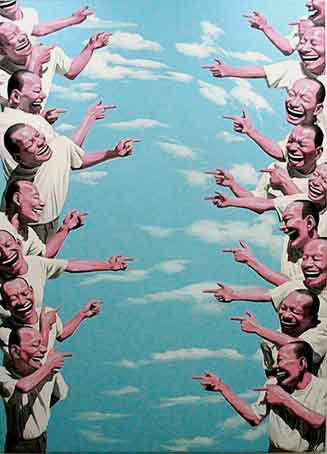Today Art Museum and Contemporary Art in China
|
|
|
[See photo 2, work by wang guangy] |
Wang Guangyi is the father of the Chinese Pop Art movement. Wang Guangyi was born in Harbin, Heilongjiang Province in 1956 or 1957. In 1984 Wang Guangyi graduated from the Zhejiang Academy of Fine Art oil painting department. He currently lives and works in Beijing.
Great Criticism paintings "respond to the recent influx of advertising including the Coca-Cola logo with an image of a Chinese soldier, thus combining both the Chinese historical experience and American pop art."
The irony in his paintings is the irony of a clash of generations and the uncontrollable changes man and society are going through in his 'Great Criticism' series, images from the 1960's. They see modern brands such as Coca-Cola, Chanel and Swatch as a new source of admiration and worship. Idealism and materialism are mixed to form what Wang calls 'Anatomic Structuralism', where visual symbols lose their original meaning. This results in a strong sense of irony.
|
|
|
[See photo 3, work by Zhang Xiaogang] |
Zhang Xiaogang, born in 1958, is the third of these artists. Classified as a contemporary Chinese symbolist and surrealist painter; best known for his Bloodline series of paintings, which are often monochromatic, stylized portraits of Chinese people, usually with large, dark-pupated eyes posed in a stiff manner reminiscent of family portraits from the 1950s and 60s.
We all live 'in a big family' says Zhang. The first lesson we learn is how to protect ourselves and keep our experiences locked in an inner chamber away from the prying eyes, while at the same time living in harmony as a member of this big family. In this sense, the "family" is a unit for the continuity of life and an idealized mechanism for procreation. It embodies power, hope, life, envy, lies, duty and love. The 'family' becomes the standard model and the focus for the contradictions of life. We interact and depend on each other for support and assurances.
 0
0 








